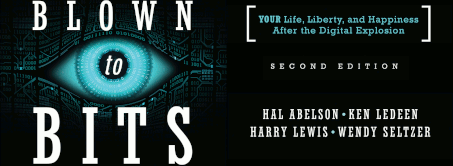The Information in Your Plumbing
Saturday, October 17th, 2009 by Harry LewisIn Chapter 2 of Blown to Bits we spend a lot of time on the way that cheap, distributed sensors have greatly increased the data we produce doing ordinary things. Our cars generate data just by braking and accelerating, and by going through toll booths; our supermarket purchases generate data when the barcoded items are scanned; everybody with a cell phone generates data, whether or not they are talking on the phone. These data trails produce footprints and fingerprints — records of our lives that we may or may not realize we are leaving behind.
Last week I heard a talk that made me realize how limited this mental framework was. Shwetak Patel, a 27-year-old assistant professor at the University of Washington, simply observed that lots of things people always did around their houses in the pre-digital era generate signals, which we are only now in a position to digitize and analyze.
Consider your plumbing, for example. Water comes into your house in one place, and the input is connected to a closed network running through all your faucets and toilets and even your water heater. If you were to bang on a pipe anywhere, it would ring every other pipe in the house.
Every time water flow is started or stopped–every time a valve is opened or closed–a shock wave is generated. When the shock wave is strong enough, for example if you shut a full-flowing faucet off abruptly, you cause a “water hammer” that audibly shakes pipes all through the house. But even small valves closing gently cause a mini-hammer–your automatic dishwasher shutting off, for example.
What Patel figured out is that every kind of valve causes its own distinctive ring. Your toilet is different from your shower, which is different from your lawn sprinkler. Patel figured out that you can listen to the pipe in one place–think of those old Western movies in which the Indians (as they were then called) listened to the rails for an approaching train–and monitor the plumbing activity in the whole house. By gathering data over an extended period, you can figure out how often people go to the bathroom, and which bathrooms they are using.
This is, of course, potentially very useful for monitoring utility usage, and for learning how people live. It is also, needless to say, quite creepy.
That’s just water. Patel can do the same thing with electricity. Your electric wiring is a big antenna. Flip a switch anywhere and it causes a transient in the wiring which produces electromagnetic radiation, which can be detected and analyzed. Oh, so I see you aren’t actually using compact fluorescents in your house.
Same for gas lines. Same even for HVAC systems–get a sensor inside an air duct and you can tell when people enter or leave the room, because they cause pressure changes that result in small air flows.
For different utilities, Patel requires different kinds of sensor installation. For different levels of specificity, he may need to calibrate the house. Other things he can figure out just by getting access to the utility line at any point, even where it enters the house from the outside.
Patel is a remarkably energetic and creative character. H is a winner of the Technology Review TR35 competition for inventors under 35. He has a fascinating history–he earned plumbers and electricians licenses while he was in high school and working for Habitat for Humanity, but wanted to do something more interesting than hammering nails. The intuition he gained there about how utility systems work meshed beautifully with his electrical engineering training in college.
We say in Chapter 8, about electromagnetic radiation, that one person’s noise is another’s signal. Patel’s work illustrates that beautifully. Listen to any of these utilities and you will hear random noise, which has made it hard, for example, to use domestic electric wiring for IP broadband diffusion. Turns out that noise has lots of information within it–you just have to know how to listen to it and what to do with the results.
